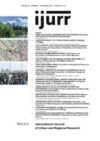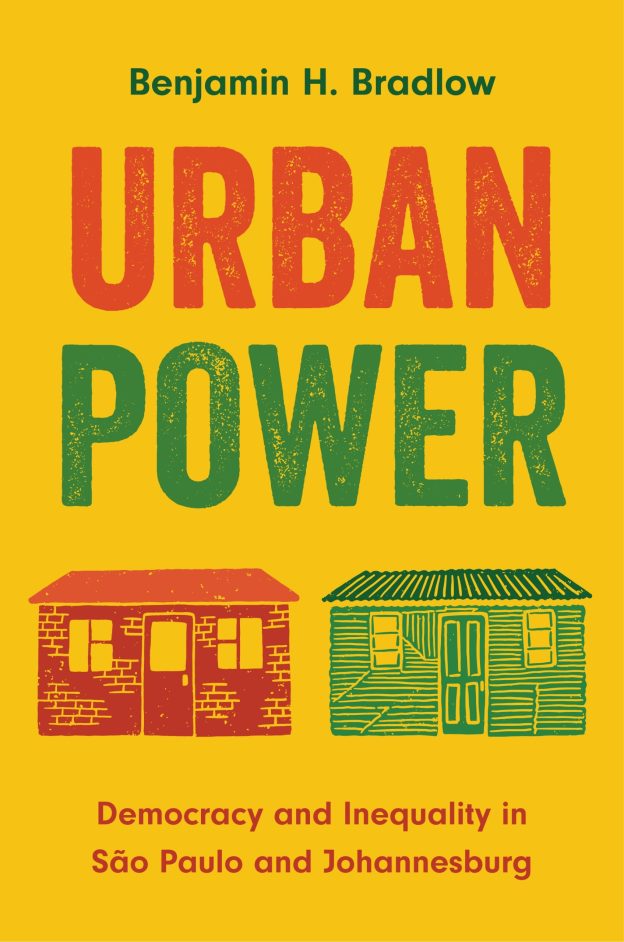In recent decades, rapid urbanization in the global South has produced megacities characterized by stark inequalities, with millions residing in slums that lack adequate access to housing, transportation and sanitation. São Paulo and Johannesburg—two of the largest and most unequal cities globally, both located in countries with a recent history of democratization—exemplify these challenges. Informal settlements on the urban peripheries of both cities experience profound social exclusion compared to the more privileged central areas. However, as this book by Benjamin H. Bradlow demonstrates, cities adopt varying approaches to governing urban inequality, even when confronted with similar challenges.
Urban Power: Democracy and Inequality in São Paulo and Johannesburg addresses a critical puzzle in contemporary urban studies: why are some cities more effective than others at reducing inequality? By exploring this question, Bradlow investigates the processes and mechanisms that enable some cities to integrate marginalized slum communities with improved access to public goods while others continue to exclude them. Across six chapters, the author compares São Paulo and Johannesburg, showing that despite their similar contexts, the two cities have adopted different approaches to addressing urban inequality since democratization in the late twentieth century. Drawing on 16 months of extensive fieldwork and over 200 interviews explored through a multi-level analysis, Bradlow’s comparative and insightful book illuminates that, even though faced with similar challenges, São Paulo has been more successful than Johannesburg in improving access to urban public goods.
Bradlow argues that understanding urban inequality across megacities hinges on the concept of urban power, which he defines as coordination of the formal and informal social relations that shape the institutions responsible for allocating public goods. Central to this understanding are two key dimensions: embeddedness and cohesion. Embeddedness refers to the connections between local governments and civil society (especially social movements) that drive policy changes focused on improving human development. Cohesion pertains to the ability of local governments to coordinate both internally (horizontal cohesion) and across different levels of government (vertical cohesion) in order to implement policies effectively.
Bradlow posits that varying configurations of embeddedness and cohesion create four distinct governance regimes: rentier (low embeddedness, low cohesion); managerial (low embeddedness, high cohesion); mobilizational (high embeddedness, low cohesion); and integrationist (high embeddedness, high cohesion). Applying this framework, he classifies São Paulo and Johannesburg as mobilizational regimes during their periods of democratization. However, he empirically demonstrates that since then, São Paulo has transitioned to an integrationist regime, while Johannesburg has moved along a rentier path marked by lower embeddedness and cohesion, creating less favorable governance conditions for effectively addressing urban inequality.
The book’s central argument is introduced in chapter 1 and further developed in chapter 2, which offers a historical overview of São Paulo and Johannesburg and examines the evolution of access to public goods in recent decades. In the following chapters, the author applies the framework to three policy sectors (housing, transportation and sanitation) to demonstrate its relevance. Chapter 3 indicates that São Paulo’s housing policy benefited from sustained partnerships between social movements and the municipal government, fostering embeddedness. These partnerships created favorable conditions for building internal bureaucratic capacity and establishing linkages between local and national governments, enhancing cohesion and leading to equitable outcomes in the city’s most marginalized areas. In contrast, Johannesburg’s housing policy suffered from a lack of connections between municipal authorities and social housing movements. This low level of embeddedness hindered the development of bureaucratic coordination within and across different levels of government, limiting its ability to challenge the influence of the private real estate market effectively. Chapters 4 and 5 extend the analysis to collective transportation and sanitation, highlighting some sector-specific dynamics. Together with the conclusion in chapter 6, these case studies strongly demonstrate how varying levels of embeddedness and cohesion shape the distribution of urban public goods.
The book makes several significant contributions to the expanding field of comparative urban studies. First, its evidence-based, historical approach provides a valuable perspective on urban inequality by comparing two cities from different continents that experience(d) similar challenges. The rigorous research design, combined with the book’s clear structure and compelling writing, not only addresses urban inequality but also highlights the limitations of current explanations in the literature, especially those developed for cities in the global North. Second, the book enhances its analysis by incorporating a temporal dimension, demonstrating how the sequencing of events plays a crucial role in explaining variations in configurations of embeddedness and cohesion. Third, it underscores the importance of stakeholders and institutional rules in shaping urban trajectories. By emphasizing the agency of local actors and the significance of alliances and conflicts, the book challenges theoretical traditions that often downplay the role of stakeholders in shaping urban dynamics. Fourth, its interdisciplinary approach situates the analysis within broader debates on inequality, urbanization and democracy. Finally, the book’s external validity extends beyond its two case cities, offering a robust and applicable framework for analyzing urban governance and inequalities in diverse global contexts in both the global South and North.
Despite its numerous strengths and significant contributions, one minor critique concerns the applicability of the urban power argument across different policy sectors. Prior research highlights that housing, transportation and sanitation possess distinct spatial, political and economic dynamics, engage distinct societal actors, and involve different degrees of state intervention and penetration. While the author acknowledges some of these factors, a deeper exploration of sector-specific dynamics could have enhanced the argument’s applicability, particularly in relation to transportation, where the argument occasionally appears less fitting compared to housing or sanitation. Nonetheless, this minor critique does not take away from the book’s overall impact.
Urban Power is a landmark contribution to the study of urban governance and inequality, particularly in new democracies where addressing persistent patterns of social and spatial exclusion and improving the quality of life for slum residents are urgent priorities. The framework provides a robust analytical tool for scholars exploring urban dynamics and the distribution of public goods in São Paulo, Johannesburg and other cities worldwide. Ultimately, Bradlow’s insights promise to influence future debates on democracy, urbanization and the equitable provision of public goods in rapidly transforming urban environments.
Ivan Souza Vieira, National Autonomous University of Mexico
Benjamin H. Bradlow 2024: Urban Power: Democracy and Inequality in São Paulo and Johannesburg. Princeton, NJ: Princeton University Press.
Views expressed in this section are independent and do not represent the opinion of the editors.

